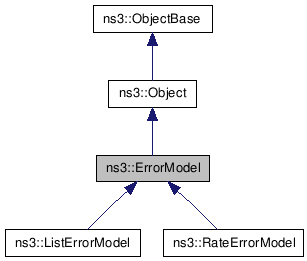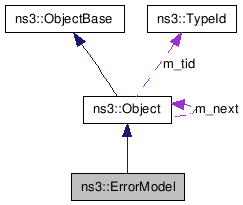ns3::ErrorModel Class Reference
[Error Model]
General error model that can be used to corrupt packets.
More...
#include <error-model.h>


Public Member Functions | |
| bool | IsCorrupt (Ptr< Packet > pkt) |
| void | Reset (void) |
| void | Enable (void) |
| void | Disable (void) |
| bool | IsEnabled (void) const |
Static Public Member Functions | |
| static TypeId | GetTypeId (void) |
| This method returns the TypeId associated to ns3::ErrorModel. | |
Detailed Description
General error model that can be used to corrupt packets.This object is used to flag packets as being lost/errored or not. It is part of the Object framework and can be aggregated to other ns3 objects and handled by the Ptr class.
The main method is IsCorrupt(Ptr<Packet> p) which returns true if the packet is to be corrupted according to the underlying model. Depending on the error model, the packet itself may have its packet data buffer errored or not, or side information may be returned to the client in the form of a packet tag. The object can have state (resettable by Reset()). The object can also be enabled and disabled via two public member functions.
Typical code (simplified) to use an ErrorModel may look something like this:
Ptr<ErrorModel> rem = CreateObject<RateErrorModel> (); rem->SetRandomVariable (UniformVariable ()); rem->SetRate (0.001); ... Ptr<Packet> p; if (rem->IsCorrupt (p)) { dropTrace(p); } else { Forward (p); }
Two practical error models, a ListErrorModel and a RateErrorModel, are currently implemented.
Member Function Documentation
| void ns3::ErrorModel::Disable | ( | void | ) |
Disable the error model
| void ns3::ErrorModel::Enable | ( | void | ) |
Enable the error model
| static TypeId ns3::ErrorModel::GetTypeId | ( | void | ) | [static] |
This method returns the TypeId associated to ns3::ErrorModel.
This object is accessible through the following paths with Config::Set and Config::Connect:
- /NodeList/[i]/DeviceList/[i]/$ns3::CsmaNetDevice/ReceiveErrorModel
- /NodeList/[i]/DeviceList/[i]/$ns3::PointToPointNetDevice/ReceiveErrorModel
-
IsEnabled: Whether this ErrorModel is enabled or not.
- Set with class: BooleanValue
- Underlying type: bool
- Initial value: true
- Flags: construct write read
Reimplemented from ns3::Object.
Reimplemented in ns3::RateErrorModel, and ns3::ListErrorModel.
| bool ns3::ErrorModel::IsEnabled | ( | void | ) | const |
- Returns:
- true if error model is enabled; false otherwise
| void ns3::ErrorModel::Reset | ( | void | ) |
Reset any state associated with the error model
The documentation for this class was generated from the following files:
- src/common/error-model.h
- doc/introspected-doxygen.h
 1.5.8
1.5.8